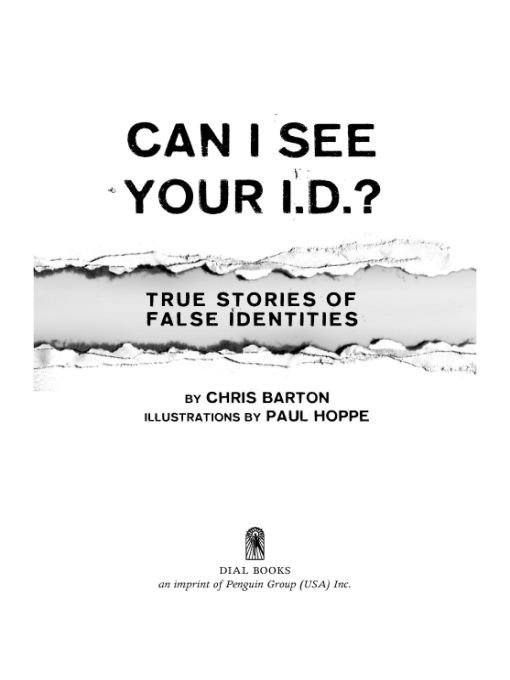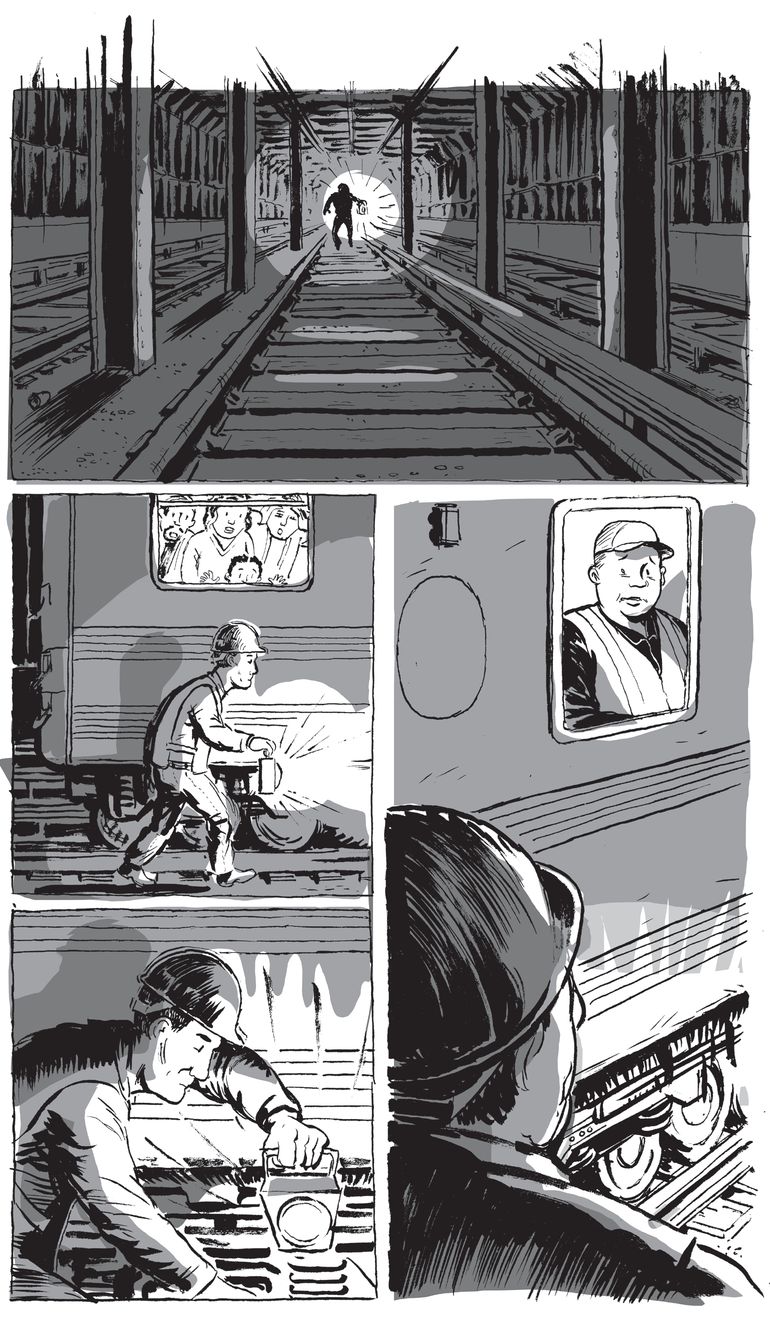Can I See Your I. D.?
Read Can I See Your I. D.? Online
Authors: Chris Barton



Table of Contents
Â
Â
Â
DIAL BOOKS
An imprint of Penguin Group (USA) Inc.
Published by The Penguin Group
Penguin Group (USA) Inc., 375 Hudson Street,
New York, NY 10014, U.S.A.
Penguin Group (Canada), 90 Eglinton Avenue East, Suite 700,
Toronto, Ontario, Canada M4P 2Y3
(a division of Pearson Penguin Canada Inc.)
Penguin Books Ltd, 80 Strand, London WC2R 0RL, England
Penguin Ireland, 25 St. Stephen's Green, Dublin 2, Ireland
(a division of Penguin Books Ltd)
Penguin Group (Australia), 250 Camberwell Road,
Camberwell, Victoria 3124, Australia
(a division of Pearson Australia Group Pty Ltd)
Penguin Books India Pvt Ltd, 11 Community Centre,
Panchsheel Park, New Delhi - 110 017, India
Penguin Group (NZ), 67 Apollo Drive, Rosedale, North Shore 0632,
New Zealand (a division of Pearson New Zealand Ltd)
Penguin Books (South Africa) (Pty) Ltd, 24 Sturdee Avenue,
Rosebank, Johannesburg 2196, South Africa
Penguin Books Ltd, Registered Offices: 80 Strand,
London WC2R 0RL, England
Published by The Penguin Group
Penguin Group (USA) Inc., 375 Hudson Street,
New York, NY 10014, U.S.A.
Penguin Group (Canada), 90 Eglinton Avenue East, Suite 700,
Toronto, Ontario, Canada M4P 2Y3
(a division of Pearson Penguin Canada Inc.)
Penguin Books Ltd, 80 Strand, London WC2R 0RL, England
Penguin Ireland, 25 St. Stephen's Green, Dublin 2, Ireland
(a division of Penguin Books Ltd)
Penguin Group (Australia), 250 Camberwell Road,
Camberwell, Victoria 3124, Australia
(a division of Pearson Australia Group Pty Ltd)
Penguin Books India Pvt Ltd, 11 Community Centre,
Panchsheel Park, New Delhi - 110 017, India
Penguin Group (NZ), 67 Apollo Drive, Rosedale, North Shore 0632,
New Zealand (a division of Pearson New Zealand Ltd)
Penguin Books (South Africa) (Pty) Ltd, 24 Sturdee Avenue,
Rosebank, Johannesburg 2196, South Africa
Penguin Books Ltd, Registered Offices: 80 Strand,
London WC2R 0RL, England
Â
Text copyright © 2011 by Chris BartonIllustrations copyright © 2011 by Paul Hoppe
Â
All rights reserved
The publisher does not have any control over and does not
assume any responsibility for author or
third-party websites or their content.
The publisher does not have any control over and does not
assume any responsibility for author or
third-party websites or their content.
Â
Â
Â
Library of Congress Cataloging-in-Publication Data
Barton, Chris.
Can I see your I.D.? : true stories of false identities /
by Chris Barton ; illustrations by Paul Hoppe.
p. cm.
Includes bibliographical references.
Barton, Chris.
Can I see your I.D.? : true stories of false identities /
by Chris Barton ; illustrations by Paul Hoppe.
p. cm.
Includes bibliographical references.
eISBN : 978-1-101-47636-9
1. Impostors and impostureâBiographyâJuvenile literature.
2. False personationâCase studiesâJuvenile literature. 3. Identity (Psychology)â
Case studiesâJuvenile literature. I. Hoppe, Paul, ill. II. Title.
CT9980.B34 2011
001.9'5âdc22
2010011878
2. False personationâCase studiesâJuvenile literature. 3. Identity (Psychology)â
Case studiesâJuvenile literature. I. Hoppe, Paul, ill. II. Title.
CT9980.B34 2011
001.9'5âdc22
2010011878
For Mom, Dad,
and Joe T. Moore
and Joe T. Moore
âC.B.

SUBWAY MOTORMAN?
KERON THOMAS
SATURDAY, MAY 8, 1993NEW YORK CITY
If there had been trains on the island of Trinidad, where you lived until you were twelve, you might have gotten your thing for them out of your system by now. But there weren't, and you didn't, and that's why you're here at the 207th Street subway station carrying a bag of motorman's tools and signing someone else's name.
If all goes well, they'll never know that your name is Keron Thomas and that you're sixteen. If all goes well, they'll believe you when you tell them that you're Regoberto Sabio, and they'll have no idea that he's supposed to be forty-four years old. You're a six-footer, but you can't pass for forty-four. Twenty-four, maybe. But not forty-four.
You met Sabio while you were hanging out on the Franklin Avenue Shuttle he operates weekday afternoons and evenings back in Brooklyn. You knew so much about the subway already that you didn't come off as suspiciously eager to learn more. In fact, you told Sabio you were a motorman too, on another line. Obviously, you were a young, single motorman with time on his hands and a need for a mentor. Why else would you have ridden his four-stop route back and forth in the cab with him for several hours each week since last winter?
In addition to the tools, you'd gotten your hands on this Transit Authority uniform shirt. You kept it in your bag at school, and you'd throw it on before you got to the Franklin Avenue station. Between that T.A. shirt and your calm, mature demeanor, nobody would look at you and see a teenage train fanatic. That allowed you to observe Sabio up close and learn a lot more than you could have while watching a motorman through a closed cab door.
You paid close attention to everything Sabio did. As he ran his train down the line and back, you picked up on the lingo from his radio chats with the tower. You watched him brake when he came into a station, saw how he eased the train back out again. He's a talkative guy, so there was a lot of conversation in there, a lot of advice. “Don't stay out drinking the night before you've got a shift,” he'd tell you. “Don't let management tell you how to wear your hair,” “Take notes on everything you do,” and so forth. It was all professional advice, not technical, because he thought you already knew the mechanics of operating a train, right?
Somewhere along the way, you got the idea that you probably
did
know enough to drive the train. But you didn't want to just
know
âyou wanted to
do
. And this week when Sabio mentioned that vacation he had coming up, you saw your chance.
did
know enough to drive the train. But you didn't want to just
know
âyou wanted to
do
. And this week when Sabio mentioned that vacation he had coming up, you saw your chance.
You asked some questions not too surprising coming from a rookie motorman: Who's going to take your shift while you're out? Can I do it? How do I go about getting some overtime, anyway?
He said, “Call the crew office and see what they say.”
Which you did.
Late last night.
In Sabio's name.
But you didn't ask for his Franklin Shuttle route. You told them what train you really wanted. Come on in, they told you. 207th Street station, they said. And here you areâwhere, most likely, nobody knows that the real Regoberto Sabio is not only much older than you but four inches shorter and forty pounds lighter. They probably don't know that he wears a beard or sports dreadlocks down past his waist.
“I'm the extra man,” you tell the dispatcher. “You have a train for me?”
You sign in with Sabio's nameâno pass code needed, no Transit Authority I.D. required. You catch a little grief about the way you're dressedâyou've got on your uniform shirt, but you're wearing jeans instead of the regulation blue trousers.
“Hey, you're not in your uniform pants,” he says.
“They're at the cleaners,” you say.
“I'll let you go todayâit's the weekend.”
He buys it. He believes you. You're in.
He issues you a big, bulky radio, and now you've got a train to drive.
You've studied hard for this day. Not in any classroomâAutomotive High never has taught you what you most wanted to knowâbut in the stations scattered beneath the streets of the city, and on the trains thundering through them.
All your life, you've wanted to know how things workâthe mechanics of them. What's inside a remote control that lets it run a toy car? The only way to find out is to open it up and see for yourself. And that's pretty much what you've done with the subway.
Long before you began hanging out with Sabio, you were riding the subway for fun on weekends, situated at the front of the train so you could get a peek at the tracks, see how the signals are working. Lots of kids do that, of course. But how many teenagers have train posters in their bedrooms? How many sing out “Next stop, Franklin” while pretending a piece of wood and a stapler are the controls? Or count
Rules and Regulations Governing Employees Engaged in the Operation of the New York City Transit System
among their favorite books?
Rules and Regulations Governing Employees Engaged in the Operation of the New York City Transit System
among their favorite books?
Becoming one of those employees after you graduate would be greatâbut you're impatient. Why wait until then to drive a train when you see a way you can do it
now
?
now
?
When the dispatcher told you to report way up at 207th, it could mean only one thing: You got the train you asked for.
The A.
You've hit the jackpot. The A train is the longest line in the system. You've heard it's also one of the hardest lines for a beginning operator to learn on, because it involves lots of switching on and off different tracks. That's good. You want a little challenge.
The A.
You've hit the jackpot. The A train is the longest line in the system. You've heard it's also one of the hardest lines for a beginning operator to learn on, because it involves lots of switching on and off different tracks. That's good. You want a little challenge.
You're not stealing the train, any more than someone can steal an escalatorâit's going to come right back to where you got it, isn't it? At least, that's how you see it as you walk out onto the platform with your bag containing a motorman's two main toolsâa brake handle and a reverser keyâalong with a Day-Glo orange safety vest.
You do like you've seen Sabio doâcharge up the air compressors that power the brakes, walk through the train, make sure everything's in order. Then you step into the cab and wait for the conductor to give you two long buzzes. You give him two short ones in reply. It's 3:58 p.m.âtime to go.
Sabio's shuttle is just two cars long, but the A has eightâthat's six hundred feet of train. The controls are also different from the ones you've watched Sabio operate, but that's all right. You'll figure them out. All you need to do is justâ
Uh-oh.
The train starts to move backward. That's
never
supposed to happen. You put on the brake, but not before you feel the train nudge the bumping block behind it. Hoping nobody noticed, you reverse direction and pull out of the station.
never
supposed to happen. You put on the brake, but not before you feel the train nudge the bumping block behind it. Hoping nobody noticed, you reverse direction and pull out of the station.
You accelerate.
You're in control. You're used to the rattle and the clatter and the whine of the trains, but this power, this exhilarationâthis feeling is new, and you've never known anything better. You
knew
you could do it. You feel like a pro.
knew
you could do it. You feel like a pro.
This train is taking youâno,
you're
taking
it
âthe entire length of Manhattan, clear across Brooklyn, and all the way out to Lefferts Boulevard on the edge of Queens. Running time: about an hour fifteen. You'll haul hundreds of passengers, maybe thousandsânone of them with any idea who's behind this cab door. They're a trusting bunchânot trusting in
you
, exactly, but in the T.A. You know what you're doing, though, so they're in good hands all the same.
you're
taking
it
âthe entire length of Manhattan, clear across Brooklyn, and all the way out to Lefferts Boulevard on the edge of Queens. Running time: about an hour fifteen. You'll haul hundreds of passengers, maybe thousandsânone of them with any idea who's behind this cab door. They're a trusting bunchânot trusting in
you
, exactly, but in the T.A. You know what you're doing, though, so they're in good hands all the same.
When you get to Lefferts, you need to change onto a Brooklyn-bound train. But you can't get your radio out of the cabâthat requires a key that you don't have. On the platform, you spot another motorman.
“Hey, can I borrow your radio key?” you ask. “I lost mine.”
“Yeah, no problem!” he says.
Radio removed and complication resolved, you slide into the cab of your next train for your return to 207th Street. Back you go, easing into and out of the stations at Euclid Avenue, Jay Street, Fulton, World Trade Center, Washington Square, Penn Station, Forty-second Street, and on up Eighth Avenue.
Other books
Exilio: Diario de una invasión zombie by J. L. Bourne
MisMatch (A Humorous Contemporary Romance) by Nana Malone
Leave It to Cleavage by Wendy Wax
Sarah Armstrong - 02 - Blood Lines by Kathryn Casey
The Butcher's Theatre by Jonathan Kellerman
To Trust Her Heart by Carolyn Faulkner
Rekindling Christmas by Hines, Yvette
RoamWild by Valerie Herme´
The Briar King by Greg Keyes
Just for Fins by Tera Lynn Childs